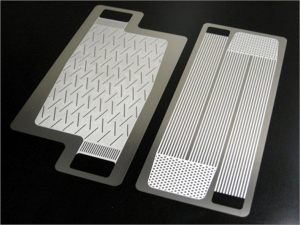Hitachi Metals declared that it has productively developed metal interconnects that contain increased level of oxidation resistance and sturdiness for effective deployment in solid oxide fuel cells (SOFC). The interconnects are used for connecting two isolated cells electrically.
 Interconnect Processing (Etching)
Interconnect Processing (Etching)
The material used in the manufacture of interconnects need to have attributes such as good electrical conductivity, constant level of thermal expansion roughly to the level of zirconia ceramics electrolytes, and above all oxidation resistance to perform in functional temperature ranges such as 700–850°C continuously. In its pursuit to find a suitable interconnect material, the company tested various materials and encountered problems. In the use of normal stainless steel (430ss and others) it faced insufficient level of oxidation. The nickel-based alloys such as alloy 600 provided good oxidation resistance but the coefficient of thermal expansion was more in them. Similarly aluminum alloys with good oxidation resistance suffered poor electrical conductivity at the oxide scale.
Hitachi Metals keen to overcome the inherent deficiency level of various metals tested them to meet the exacting requirements. It had first developed ZMGTM232L, a ferritic stainless steel material in 2005. Now it has announced the successful development of interconnect materials ZMGTM232J3 and ZMGTM232G10 with improved levels of strength, oxidation resistance and electrical conductivity achieved by its earlier developed ZMGTM232L. The company not limiting its role in supply of materials has been taking initiatives to meet the individual requirements of a range of clients.